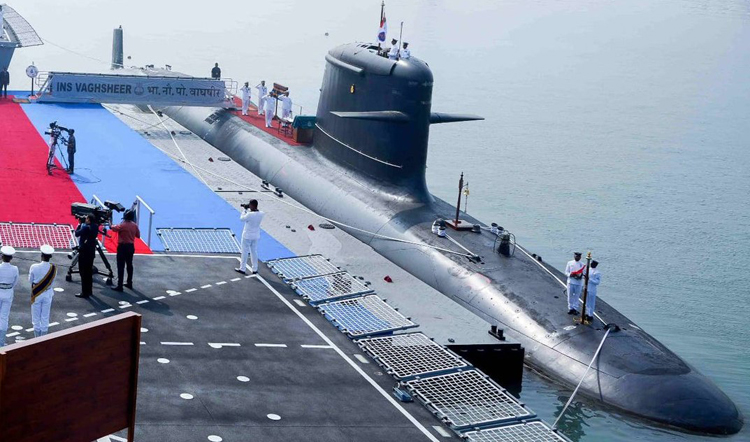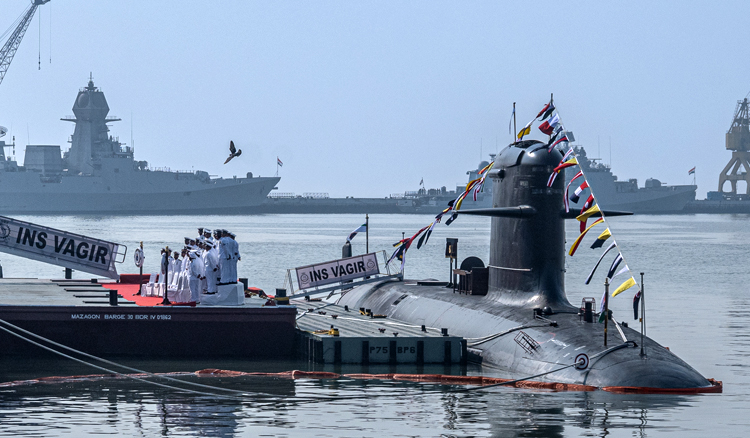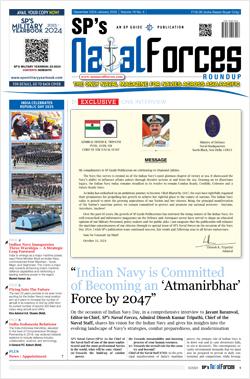INDIAN ARMED FORCES CHIEFS ON OUR RELENTLESS AND FOCUSED PUBLISHING EFFORTS

The insightful articles, inspiring narrations and analytical perspectives presented by the Editorial Team, establish an alluring connect with the reader. My compliments and best wishes to SP Guide Publications.

"Over the past 60 years, the growth of SP Guide Publications has mirrored the rising stature of Indian Navy. Its well-researched and informative magazines on Defence and Aerospace sector have served to shape an educated opinion of our military personnel, policy makers and the public alike. I wish SP's Publication team continued success, fair winds and following seas in all future endeavour!"

Since, its inception in 1964, SP Guide Publications has consistently demonstrated commitment to high-quality journalism in the aerospace and defence sectors, earning a well-deserved reputation as Asia's largest media house in this domain. I wish SP Guide Publications continued success in its pursuit of excellence.
- MoD initiates comprehensive review of Defence Acquisition Procedure 2020, pushes for defence reforms
- G7: The Swansong
- Kalinga Connect: South Asia to Polynesia
- Advanced MRSAM for India for a greater firepower
- Must Credit DRDO for Operation Sindoor, now what is next for defence R&D?
- Operation Sindoor | Day 2 DGMOs Briefing
- Operation Sindoor: Resolute yet Restrained
Next Generation Submarine – Project 76
The government has approved a $9 billion deal involving MDL and Germany's TKMS for the design and construction of the next generation submarine under Project 76
 |
The Author is Former Director General of Information Systems and A Special Forces Veteran, Indian Army |

The government has approved a $9 billion deal involving Mazagaon Docks Limited (MDL) and Germany's Thyssenkrupp Marine Systems (TKMS) for the design and construction of the next generation submarine under Project 76 according to news reports of January 25, 2025. The deal includes comprehensive Transfer of Technology (ToT) aimed at enabling India to eventually enable India to make its own submarine designs.
The Defence Research and Development Organisation (DRDO) has also taken up a preliminary study on the design and development of an indigenous conventional submarine under Project 76
The Defence Research and Development Organisation (DRDO) has also taken up a preliminary study on the design and development of an indigenous conventional submarine under Project 76. Under this Project 76, the Warship Design Bureau of the Indian Navy is working on designing and developing the country's first indigenously conventional diesel-electric submarine. The Indian Navy wants to build 12 submarines under Project 76. Envisioned as air-independent propulsion (AIP) equipped diesel-electric attack submarines, these submarines, expected to have a submerged displacement of 3,000 tonnes, representing a leap beyond their foreign-designed predecessors like Project-75(I) and Project-75 submarines. The project is looking beyond the 'Sindhughosh' (Kilo) class submarines, focussing on the Navy's commitment to maintain a robust 3,000-tonne class of submarines. The submarine under Project 76 is expected to feature some of the most advance features such as, indigenous Weapon Control system and Lithium-ion batteries. This would represent a pivotal milestone in India's pursuit of maritime supremacy, amalgamating top-tier French technology from Project 75 and the expertise of foreign collaboration from Project 75(I). The objective is to initiate the construction of the prototype by 2028. This undertaking holds immense significance for India's submarine-building capabilities, aiming to reduce reliance on foreign Original Equipment Manufacturers (OEMs) for submarine design.

The collaboration with TKMS marks the third major attempt by India at acquiring requisite submarine technology over the past four decades. The pursuit began in 1981 when India procured the Type 209/1500 submarines from the German firm Howaldtswerke-Deutsche Werft (HDW), the predecessor of the TKMS group. Under the deal, two submarines were built in Germany and two were constructed at the MDL. The project was hit by a bribery scandal in 1987, which led to the blacklisting of the HDW firm, as a follow up of which, the project was stalled.
Envisioned as air-independent propulsion (AIP) equipped diesel-electric attack submarines, these submarines represent a leap beyond their foreign-designed predecessors like Project-75(I) and Project-75 submarines
India's second attempt was with the Scorpene-class submarines under Project 75, which was signed with the French Naval Group. Under this deal, six submarines were built, with three more planned. However, despite this achievement, the ToT was incomplete, which was criticized by both MDL and the Indian Navy since it was insufficient to indigenously design and construct future submarines. This is what later led to the initiation of the long overdue Project 75(I).
The Indian Navy and the MDL have been facing criticism for lacking the will or expertise to fully integrate advanced technologies in the submarine projects. But the irony is no one wants to look beyond, which appears to be by design, not by default. It is an established fact that some of the bureaucrats have their own agenda, being part of the deep state. In mid-1997, then Naval Chief Admiral Vishnu Bhagwat had predicted that he would be sacked because he was pushing for submarine collaboration with Republic of Korea which was well advanced in submarine production, but the bureaucracy was stuck on the HDW submarines which no one talks about. Admiral Bhagwat was eventually sacked on December 30, 1999 but we continue to rely on the Germans and French despite their failure providing us sufficient ToT to enable indigenous design and development of future submarines. Rather than blaming MDL and the Indian Navy, did the government seriously take up on government-to-government basis default in ToT by these firms, and if not, why not?
The collaboration with TKMS marks the third major attempt by India at acquiring requisite submarine technology over the past four decades
The question is, are we again chasing a chimera in Project 76? What if TKMS still does not provide requisite ToT, enabling us to design and develop indigenous submarines in the future? No doubt developing an indigenous submarine requires a skilled workforce and long-term vision, but don't our dockyards have adequate skilled workforce – haven't their skills improved over the decades? Over-reliance on foreign collaboration for key technologies impacts our strategic autonomy adversely, yet we want to act saintly, defying Chanakya's dictum of Sam, Daam, Dand, Bhed. Everything is fair in war, and the same goes for critical military technologies. It is not just China that follows Chanakya's dictum, the POTUS Donal Trump has accused Russia of stealing hypersonic technologies from the US. Yet, we have not even been able to reverse-engineer even aero engines and air-independent propulsion technology, leave aside developing our own.

Considering that foreign partners have failed to transfer sufficient submarine-related technologies in the past, the stakes are high in Project 76. Perhaps a government-to-government demanding 100 per cent ToT from TKMS is warranted. In addition, Prime Minister Narendra Modi may consider mentioning this to whoever is elected German Chancellor in the elections later this month.
Project 77 (formerly Project 75 Alpha) to procure nuclear-powered attack submerges for the Indian Navy has also been in the works
Project 77 (formerly Project 75 Alpha) to procure nuclear-powered attack submerges for the Indian Navy has also been in the works. Government approved construction of six of these submarines in February 2015, designed by the Navy's in-house Directorate of Naval Design (now Warship Design Bureau) and built in India at the Ship Building Centre at Visakhapatnam. The construction was expected to commence in 2023-24, with the first submarine expected to enter service in 2032. However, further and final clearance for initially acquiring two nuclear submarines, under the Project 77, was approved on October 10, 2024. The new indigenous submarines are to be powered by a miniature pressurised water reactor (PWR) being developed by the Bhabha Atomic Research Centre which has already supplied a similar 83 MW miniature reactor for the Arihant-class submarines- SSBNs.
Characteristics of the submarines to be built under Project 77 include: Type – nuclear attack submarines; Displacement - 10,000 tonnes (9,800 long tonnes, 11,000 short tonnes); Propulsion – 1 x CLWR-82 (Compact light-water reactor) 190 MW (2,50,000 hp) 1 x single shaft pump-jet propulsion; Range – unlimited except by food supplies; Armament – Varunastra heavyweight torpedo, Nirbhay, BrahMos-II land-attack/anti-ship cruise missile.





